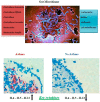The Role of the Microbiome in Asthma: The Gut⁻Lung Axis
- PMID: 30598019
- PMCID: PMC6337651
- DOI: 10.3390/ijms20010123
The Role of the Microbiome in Asthma: The Gut⁻Lung Axis
Abstract
Asthma is one of the most common chronic respiratory diseases worldwide. It affects all ages but frequently begins in childhood. Initiation and exacerbations may depend on individual susceptibility, viral infections, allergen exposure, tobacco smoke exposure, and outdoor air pollution. The aim of this review was to analyze the role of the gut⁻lung axis in asthma development, considering all asthma phenotypes, and to evaluate whether microbe-based therapies may be used for asthma prevention. Several studies have confirmed the role of microbiota in the regulation of immune function and the development of atopy and asthma. These clinical conditions have apparent roots in an insufficiency of early life exposure to the diverse environmental microbiota necessary to ensure colonization of the gastrointestinal and/or respiratory tracts. Commensal microbes are necessary for the induction of a balanced, tolerogenic immune system. The identification of commensal bacteria in both the gastroenteric and respiratory tracts could be an innovative and important issue. In conclusion, the function of microbiota in healthy immune response is generally acknowledged, and gut dysbacteriosis might result in chronic inflammatory respiratory disorders, particularly asthma. Further investigations are needed to improve our understanding of the role of the microbiome in inflammation and its influence on important risk factors for asthma, including tobacco smoke and host genetic features.
Keywords: asthma; atopy; gut microbiota; immunity; lung microbiota; microbiome.
Conflict of interest statement
The authors declare that they have no conflict of interest.
Figures

Similar articles
-
The microbiome and development of allergic disease.Curr Opin Allergy Clin Immunol. 2016 Apr;16(2):165-71. doi: 10.1097/ACI.0000000000000255. Curr Opin Allergy Clin Immunol. 2016. PMID: 26885707 Free PMC article. Review.
-
The role of the microbiome in childhood asthma.Immunotherapy. 2017 Nov;9(15):1295-1304. doi: 10.2217/imt-2017-0048. Immunotherapy. 2017. PMID: 29130800 Review.
-
Microbiome in the primary prevention of allergic diseases and bronchial asthma.Allergol Immunopathol (Madr). 2019 Jan-Feb;47(1):79-84. doi: 10.1016/j.aller.2018.03.005. Epub 2018 Jul 3. Allergol Immunopathol (Madr). 2019. PMID: 29980403 Review.
-
Does lung microbiome play a causal or casual role in asthma?Pediatr Pulmonol. 2018 Oct;53(10):1340-1345. doi: 10.1002/ppul.24086. Epub 2018 Jun 26. Pediatr Pulmonol. 2018. PMID: 29943915 Review.
-
The microbial environment and its influence on asthma prevention in early life.J Allergy Clin Immunol. 2016 Mar;137(3):680-9. doi: 10.1016/j.jaci.2015.12.1301. Epub 2016 Jan 22. J Allergy Clin Immunol. 2016. PMID: 26806048 Review.
Cited by
-
The Microbiota in Children and Adolescents with Asthma.Children (Basel). 2024 Sep 27;11(10):1175. doi: 10.3390/children11101175. Children (Basel). 2024. PMID: 39457140 Free PMC article. Review.
-
Coronavirus disease-2019 and the intestinal tract: An overview.World J Gastroenterol. 2021 Apr 7;27(13):1255-1266. doi: 10.3748/wjg.v27.i13.1255. World J Gastroenterol. 2021. PMID: 33833480 Free PMC article. Review.
-
The Protective Effects of Helicobacter pylori Infection on Allergic Asthma.Int Arch Allergy Immunol. 2021;182(1):53-64. doi: 10.1159/000508330. Epub 2020 Oct 20. Int Arch Allergy Immunol. 2021. PMID: 33080611 Free PMC article. Review.
-
Global knowledge mapping and emerging research trends in the microbiome and asthma: A bibliometric and visualized analysis using VOSviewer and CiteSpace.Heliyon. 2024 Jan 17;10(2):e24528. doi: 10.1016/j.heliyon.2024.e24528. eCollection 2024 Jan 30. Heliyon. 2024. PMID: 38304829 Free PMC article.
-
Gut Dysbiosis in Children with Cystic Fibrosis: Development, Features and the Role of Gut-Lung Axis on Disease Progression.Microorganisms. 2022 Dec 20;11(1):9. doi: 10.3390/microorganisms11010009. Microorganisms. 2022. PMID: 36677301 Free PMC article. Review.
References
Publication types
MeSH terms
Grants and funding
LinkOut - more resources
Full Text Sources
Medical

